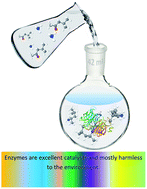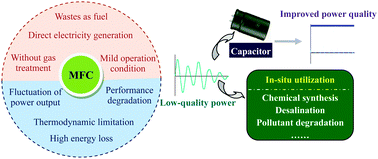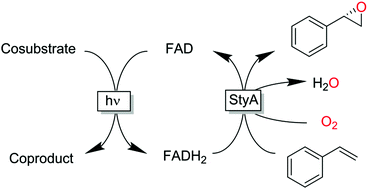Themed collection Biohybrid approaches for energy conversion

Supramolecular strategies in artificial photosynthesis
This review describes supramolecular strategies for optimization and integration of components needed for the fundamentals of artificial photosynthesis: light harvesting, charge-separation and catalysis, which are relevant for solar-to-fuel devices.

Chem. Sci., 2021,12, 50-70
https://doi.org/10.1039/D0SC03715J
The Hitchhiker's guide to biocatalysis: recent advances in the use of enzymes in organic synthesis
Enzymes are excellent catalysts that are increasingly being used in industry and academia. This Perspective provides a general and practical guide to enzymes and their synthetic potential, primarily aimed at synthetic organic chemists.

Chem. Sci., 2020,11, 2587-2605
https://doi.org/10.1039/C9SC05746C
Successes, challenges, and opportunities for quantum chemistry in understanding metalloenzymes for solar fuels research
Overview of the rich and diverse contributions of quantum chemistry to understanding the structure and function of the biological archetypes for solar fuel research, photosystem II and hydrogenases.

Chem. Commun., 2021,57, 3952-3974
https://doi.org/10.1039/D1CC00705J
Bioinspired metal complexes for energy-related photocatalytic small molecule transformation
This article features the recent progress of bioinspired metal complexes as catalysts with high stability, specific selectivity and satisfactory efficiency to drive multiple-electron and multiple-proton related to small molecule transformation.

Chem. Commun., 2020,56, 15496-15512
https://doi.org/10.1039/D0CC05870J
Design of molecular water oxidation catalysts with earth-abundant metal ions
Guiding principle to design earth-abundant water oxidation catalysts.

Chem. Soc. Rev., 2021,50, 6790-6831
https://doi.org/10.1039/D0CS01442G
Biochemical and artificial pathways for the reduction of carbon dioxide, nitrite and the competing proton reduction: effect of 2nd sphere interactions in catalysis
Reduction of oxides and oxoanions of carbon and nitrogen are of great contemporary importance as they are crucial for a sustainable environment.

Chem. Soc. Rev., 2021,50, 3755-3823
https://doi.org/10.1039/D0CS01405B
[FeFe]-Hydrogenases: maturation and reactivity of enzymatic systems and overview of biomimetic models
[FeFe]-hydrogenases recieved increasing interest in the last decades. This review summarises important findings regarding their enzymatic reactivity as well as inorganic models applied as electro- and photochemical catalysts.
![Graphical abstract: [FeFe]-Hydrogenases: maturation and reactivity of enzymatic systems and overview of biomimetic models](/no/Image/Get?imageInfo.ImageType=GA&imageInfo.ImageIdentifier.ManuscriptID=D0CS01089H&imageInfo.ImageIdentifier.Year=2021)
Chem. Soc. Rev., 2021,50, 1668-1784
https://doi.org/10.1039/D0CS01089H
Molecular catalysis of CO2 reduction: recent advances and perspectives in electrochemical and light-driven processes with selected Fe, Ni and Co aza macrocyclic and polypyridine complexes
Recent developments in (photo)electrochemical CO2 reduction combining Fe, Ni, and Co molecular complexes and (semi)conductive materials have led to high catalytic performances.

Chem. Soc. Rev., 2020,49, 5772-5809
https://doi.org/10.1039/D0CS00218F
Semi-biological approaches to solar-to-chemical conversion
This review provides an overview of the cross-disciplinary field of semi-artificial photosynthesis, which combines strengths of biocatalysis and artificial photosynthesis to develop new concepts and approaches for solar-to-chemical conversion.

Chem. Soc. Rev., 2020,49, 4926-4952
https://doi.org/10.1039/C9CS00496C
Nature-inspired electrocatalysts and devices for energy conversion
A NICE approach for the design of nature-inspired electrocatalysts and electrochemical devices for energy conversion.

Chem. Soc. Rev., 2020,49, 3107-3141
https://doi.org/10.1039/C8CS00797G
Harvest and utilization of chemical energy in wastes by microbial fuel cells
Energy generated from wastes by using MFC technology could be effectively stored and utilized for real-world applications.

Chem. Soc. Rev., 2016,45, 2847-2870
https://doi.org/10.1039/C5CS00903K
New frontiers in enzyme immobilisation: robust biocatalysts for a circular bio-based economy
This tutorial review focuses on recent advances in technologies for enzyme immobilisation, enabling their cost-effective use in the bio-based economy and continuous processing in general.

Chem. Soc. Rev., 2021,50, 5850-5862
https://doi.org/10.1039/D1CS00015B
Roadmap towards solar fuel synthesis at the water interface of liposome membranes
This tutorial review describes the physical–chemical aspects one must consider when building photocatalytic liposomes for solar fuel production.

Chem. Soc. Rev., 2021,50, 4833-4855
https://doi.org/10.1039/D0CS00737D
Tools and strategies of systems metabolic engineering for the development of microbial cell factories for chemical production
This tutorial review covers tools, strategies, and procedures of systems metabolic engineering facilitating the development of microbial cell factories efficiently producing chemicals and materials.

Chem. Soc. Rev., 2020,49, 4615-4636
https://doi.org/10.1039/D0CS00155D
Engineering enzyme microenvironments for enhanced biocatalysis
Protein engineering provides a means to alter protein structure leading to new functions.

Chem. Soc. Rev., 2018,47, 5177-5186
https://doi.org/10.1039/C8CS00085A
Artificial maturation of [FeFe] hydrogenase in a redox polymer film
We demonstrate that the insertion of the dinuclear active site of [FeFe] hydrogenase into the apo-enzyme can occur when the enzyme is embedded in a film of redox polymer, under conditions of mediated electron transfer.
![Graphical abstract: Artificial maturation of [FeFe] hydrogenase in a redox polymer film](/no/Image/Get?imageInfo.ImageType=GA&imageInfo.ImageIdentifier.ManuscriptID=D0CC08168J&imageInfo.ImageIdentifier.Year=2021)
Chem. Commun., 2021,57, 1750-1753
https://doi.org/10.1039/D0CC08168J
Kinetic and mechanistic analysis of a synthetic reversible CO2/HCO2− electrocatalyst
A kinetic and mechanistic analysis of [Pt(depe)2](PF6)2, an electrocatalyst for the reversible conversion between CO2 and HCO2− with high selectivity at low overpotentials.

Chem. Commun., 2020,56, 12965-12968
https://doi.org/10.1039/D0CC05556E
A NiRhS fuel cell catalyst – lessons from hydrogenase
Novel dry-distilled catalysts based on Rh, Ni and S were developed via a Ni(μ-S)2Rh organometallic [NiFe]hydrogenase mimic.

Chem. Commun., 2020,56, 11787-11790
https://doi.org/10.1039/D0CC04789A
Reactivation of sulfide-protected [FeFe] hydrogenase in a redox-active hydrogel
[FeFe] hydrogenases are highly active hydrogen conversion catalysts, whose oxygen sensitivity prevents their widespread application. Here, an oxygen-stable inactive form was reactivated in a redox hydrogel enabling its practical use under air.
![Graphical abstract: Reactivation of sulfide-protected [FeFe] hydrogenase in a redox-active hydrogel](/no/Image/Get?imageInfo.ImageType=GA&imageInfo.ImageIdentifier.ManuscriptID=D0CC03155K&imageInfo.ImageIdentifier.Year=2020)
Chem. Commun., 2020,56, 9958-9961
https://doi.org/10.1039/D0CC03155K
Controlled O2 reduction at a mixed-valent (II,I) Cu2S core
Oxygen reduction reactions catalyzed by a mixed-valent copper complex reveal a tuneable H2O2/H2O selectivity at room temperature together with high stability over several cycles.

Chem. Commun., 2020,56, 9636-9639
https://doi.org/10.1039/D0CC03987J
Photoenzymatic epoxidation of styrenes
Photochemical reduction of flavin adenine dinucleotide (FAD) enables the direct, non-enzymatic regeneration of styrene monooxygenase for enantiospecific epoxidation reactions.

Chem. Commun., 2019,55, 1790-1792
https://doi.org/10.1039/C8CC08149B
Chemo-bio catalysis using carbon supports: application in H2-driven cofactor recycling
Heterogeneous chemo-bio catalytic hydrogenation is an attractive strategy for clean, enantioselective C![[double bond, length as m-dash]](https://www.rsc.org/images/entities/char_e001.gif) X reduction.
X reduction.

Chem. Sci., 2021,12, 8105-8114
https://doi.org/10.1039/D1SC00295C
Phenazines as model low-midpoint potential electron shuttles for photosynthetic bioelectrochemical systems
Phenazines were explored as novel low-midpoint potential molecules for wiring cyanobacteria to electrodes.

Chem. Sci., 2021,12, 3328-3338
https://doi.org/10.1039/D0SC05655C
Visible light-driven simultaneous water oxidation and quinone reduction by a nano-structured conjugated polymer without co-catalysts
Nanostructured conjugated polymers of diphenylbutadiyne (nano-PDPB) can perform photocatalytic water oxidation under visible light excitation. Charge recovery delayed in time was exemplified by the reduction of quinone acting as a hydrogen reservoir.

Chem. Sci., 2020,11, 7324-7328
https://doi.org/10.1039/D0SC02122A
Spectroscopic investigations under whole-cell conditions provide new insight into the metal hydride chemistry of [FeFe]-hydrogenase
The mechanism of hydrogen gas formation by [FeFe] hydrogenase is probed under whole cell conditions, revealing the formation of reactive metal hydride species under physiologically relevant conditions.
![Graphical abstract: Spectroscopic investigations under whole-cell conditions provide new insight into the metal hydride chemistry of [FeFe]-hydrogenase](/no/Image/Get?imageInfo.ImageType=GA&imageInfo.ImageIdentifier.ManuscriptID=D0SC00512F&imageInfo.ImageIdentifier.Year=2020)
Chem. Sci., 2020,11, 4608-4617
https://doi.org/10.1039/D0SC00512F
Investigation of photocurrents resulting from a living unicellular algae suspension with quinones over time
Quinones are dual compounds able to extract photosynthetic electrons from living organisms but with long-term poisoning effects.

Chem. Sci., 2018,9, 8271-8281
https://doi.org/10.1039/C8SC03058H
Pyrene hydrogel for promoting direct bioelectrochemistry: ATP-independent electroenzymatic reduction of N2
We demonstrate a novel hydrogel material to facilitate direct bioelectrochemistry of a wide range of redox proteins and enable ATP-independent electroenzymatic reduction of N2 by nitrogenase.

Chem. Sci., 2018,9, 5172-5177
https://doi.org/10.1039/C8SC01638K
Electron transfer in an acidophilic bacterium: interaction between a diheme cytochrome and a cupredoxin
Electrochemical studies of diheme cytochrome/cupredoxin complexes provide new insights into the electron transfer pathway in an acidophilic bacterium.

Chem. Sci., 2018,9, 4879-4891
https://doi.org/10.1039/C8SC01615A
Transfer of photosynthetic NADP+/NADPH recycling activity to a porous metal oxide for highly specific, electrochemically-driven organic synthesis
A bio-hybrid material has been discovered, which offers a new direction for fast, specific enzyme-catalyzed organic synthesis.

Chem. Sci., 2017,8, 4579-4586
https://doi.org/10.1039/C7SC00850C
About this collection
Biohybrid approaches for energy conversion is a flourishing research area that combines the strengths of synthetic and materials chemistry with biology to deliver sustainable renewable energy solutions. These involve the creation of diverse bio-material interfaces (for example between proteins/enzymes/living cells and molecules/colloids/bulk materials) for electron and/or energy exchange and also includes the mimicry of biological active sites and processes by purely artificial chemical strategies.
In this themed collection, Guest Edited by Nicolas Plumeré (Technical University of Munich), Erwin Reisner (Cambridge University) and Jenny Zhang (Cambridge University), a selection of articles from the last 3 years or so showcasing innovative work carried out in this field published in Chemical Science, Chemical Communications or Chemical Society Reviews have been collected. This is in the lead up to the annual Chemical Science symposium in September 2021, which will feature some of the most exciting biohybrid approaches and possibilities for energy conversion to date.